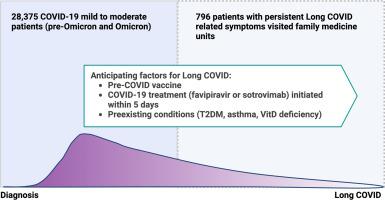当前位置:
X-MOL 学术
›
Public Health
›
论文详情
Our official English website, www.x-mol.net, welcomes your feedback! (Note: you will need to create a separate account there.)
Risk factors and early preventive measures for long COVID in non-hospitalized patients: analysis of a large cohort in the United Arab Emirates
Public Health ( IF 5.2 ) Pub Date : 2024-04-03 , DOI: 10.1016/j.puhe.2024.02.031 Fatemeh Saheb Sharif-Askari , Hawra Ali Hussain Alsayed , Narjes Saheb Sharif-Askari , Basema Saddik , Ali Al Sayed Hussain , Rabih Halwani
Public Health ( IF 5.2 ) Pub Date : 2024-04-03 , DOI: 10.1016/j.puhe.2024.02.031 Fatemeh Saheb Sharif-Askari , Hawra Ali Hussain Alsayed , Narjes Saheb Sharif-Askari , Basema Saddik , Ali Al Sayed Hussain , Rabih Halwani

|
Long COVID is characterized by persistent symptoms lasting for 4 weeks or more following the acute infection with SARS-CoV-2. Risk factors for long COVID and the impact of pre-COVID vaccination and treatment during acute COVID-19 remain uncertain. This study aimed to investigate patient-specific factors associated with long COVID in a large cohort of non-hospitalized adult patients with mild to moderate COVID-19 in Dubai. Cohort study. The study included 28,375 non-hospitalized adult patients diagnosed with mild to moderate COVID-19 between January 1, 2021, and September 31, 2022, in Dubai, who were followed up for 90 days. The presence of long COVID symptoms was documented by physicians during patient visits to the family medicine department. Furthermore, long COVID-related risk factors were collected and analyzed, including patient demographics, comorbidities, pre-COVID vaccination status, and the COVID-related treatments received during the acute phase of the illness. Cox proportional hazard models were applied for the statistical analysis. Among the cohort, 2.8% of patients experienced long COVID symptoms during the 90-day follow-up. Patients with long COVID tended to be younger, female, and of Caucasian race. Common symptoms included fatigue, muscle pain, respiratory symptoms, abdominal and neurological symptoms, allergic reactions, skin rashes, and hair loss. Risk factors for long COVID were identified as diabetes mellitus, asthma, and Vitamin D deficiency. Females and Caucasians had a higher risk of long COVID during the pre-Omicron period compared to the Omicron period. Pre-COVID vaccination was associated with a reduced risk of long COVID in all patient subgroups. Treatment with favipiravir or sotrovimab during the acute phase of COVID-19 was linked to a decreased risk of long COVID, although favipiravir showed limited effectiveness in the high-risk group. This study contributes to the existing knowledge by identifying risk factors for long COVID among non-hospitalized patients and emphasizing the potential benefits of pre-COVID vaccination and timely treatment.
中文翻译:

非住院患者长期感染新冠病毒的危险因素和早期预防措施:对阿拉伯联合酋长国大型队列的分析
长效 COVID 的特点是急性感染 SARS-CoV-2 后症状持续持续 4 周或更长时间。长期感染新冠病毒的危险因素以及新冠肺炎前疫苗接种和急性新冠肺炎 (COVID-19) 期间治疗的影响仍不确定。本研究旨在调查迪拜一大批未住院的轻度至中度 COVID-19 成人患者中与长期 COVID 相关的患者特异性因素。队列研究。该研究纳入了 2021 年 1 月 1 日至 2022 年 9 月 31 日期间在迪拜被诊断患有轻度至中度 COVID-19 的 28,375 名非住院成年患者,并对这些患者进行了 90 天的随访。医生在患者到家庭医学部门就诊时记录了长期新冠症状的存在。此外,还收集并分析了与新冠病毒相关的长期危险因素,包括患者人口统计数据、合并症、新冠病毒感染前的疫苗接种状况以及在疾病急性期接受的与新冠病毒相关的治疗。应用 Cox 比例风险模型进行统计分析。在该队列中,2.8% 的患者在 90 天的随访期间经历了长期的新冠症状。长期感染新冠病毒的患者往往更年轻、女性和白种人种。常见症状包括疲劳、肌肉疼痛、呼吸道症状、腹部和神经系统症状、过敏反应、皮疹和脱发。长期感染新冠病毒的危险因素被确定为糖尿病、哮喘和维生素 D 缺乏。与 Omicron 时期相比,女性和白人在 Omicron 之前时期长期感染新冠病毒的风险更高。在所有患者亚组中,新冠肺炎前接种疫苗与降低长期新冠肺炎风险相关。尽管法匹拉韦在高危人群中的疗效有限,但在 COVID-19 急性期使用法匹拉韦或索托维玛治疗可降低长期感染新冠病毒的风险。这项研究通过确定非住院患者中长期感染新冠病毒的危险因素,并强调新冠病毒感染前接种疫苗和及时治疗的潜在益处,为现有知识做出了贡献。
更新日期:2024-04-03
中文翻译:

非住院患者长期感染新冠病毒的危险因素和早期预防措施:对阿拉伯联合酋长国大型队列的分析
长效 COVID 的特点是急性感染 SARS-CoV-2 后症状持续持续 4 周或更长时间。长期感染新冠病毒的危险因素以及新冠肺炎前疫苗接种和急性新冠肺炎 (COVID-19) 期间治疗的影响仍不确定。本研究旨在调查迪拜一大批未住院的轻度至中度 COVID-19 成人患者中与长期 COVID 相关的患者特异性因素。队列研究。该研究纳入了 2021 年 1 月 1 日至 2022 年 9 月 31 日期间在迪拜被诊断患有轻度至中度 COVID-19 的 28,375 名非住院成年患者,并对这些患者进行了 90 天的随访。医生在患者到家庭医学部门就诊时记录了长期新冠症状的存在。此外,还收集并分析了与新冠病毒相关的长期危险因素,包括患者人口统计数据、合并症、新冠病毒感染前的疫苗接种状况以及在疾病急性期接受的与新冠病毒相关的治疗。应用 Cox 比例风险模型进行统计分析。在该队列中,2.8% 的患者在 90 天的随访期间经历了长期的新冠症状。长期感染新冠病毒的患者往往更年轻、女性和白种人种。常见症状包括疲劳、肌肉疼痛、呼吸道症状、腹部和神经系统症状、过敏反应、皮疹和脱发。长期感染新冠病毒的危险因素被确定为糖尿病、哮喘和维生素 D 缺乏。与 Omicron 时期相比,女性和白人在 Omicron 之前时期长期感染新冠病毒的风险更高。在所有患者亚组中,新冠肺炎前接种疫苗与降低长期新冠肺炎风险相关。尽管法匹拉韦在高危人群中的疗效有限,但在 COVID-19 急性期使用法匹拉韦或索托维玛治疗可降低长期感染新冠病毒的风险。这项研究通过确定非住院患者中长期感染新冠病毒的危险因素,并强调新冠病毒感染前接种疫苗和及时治疗的潜在益处,为现有知识做出了贡献。



























 京公网安备 11010802027423号
京公网安备 11010802027423号